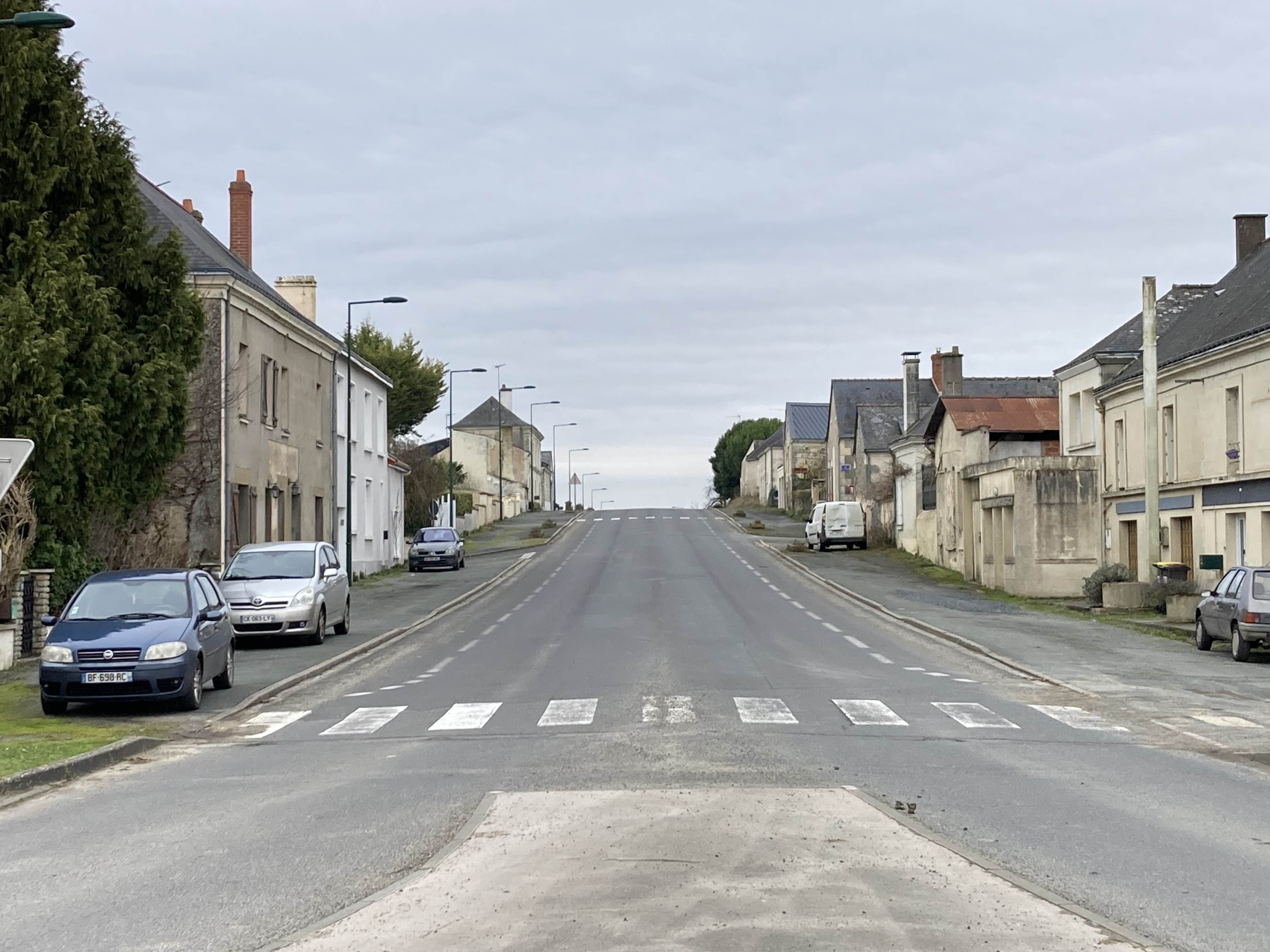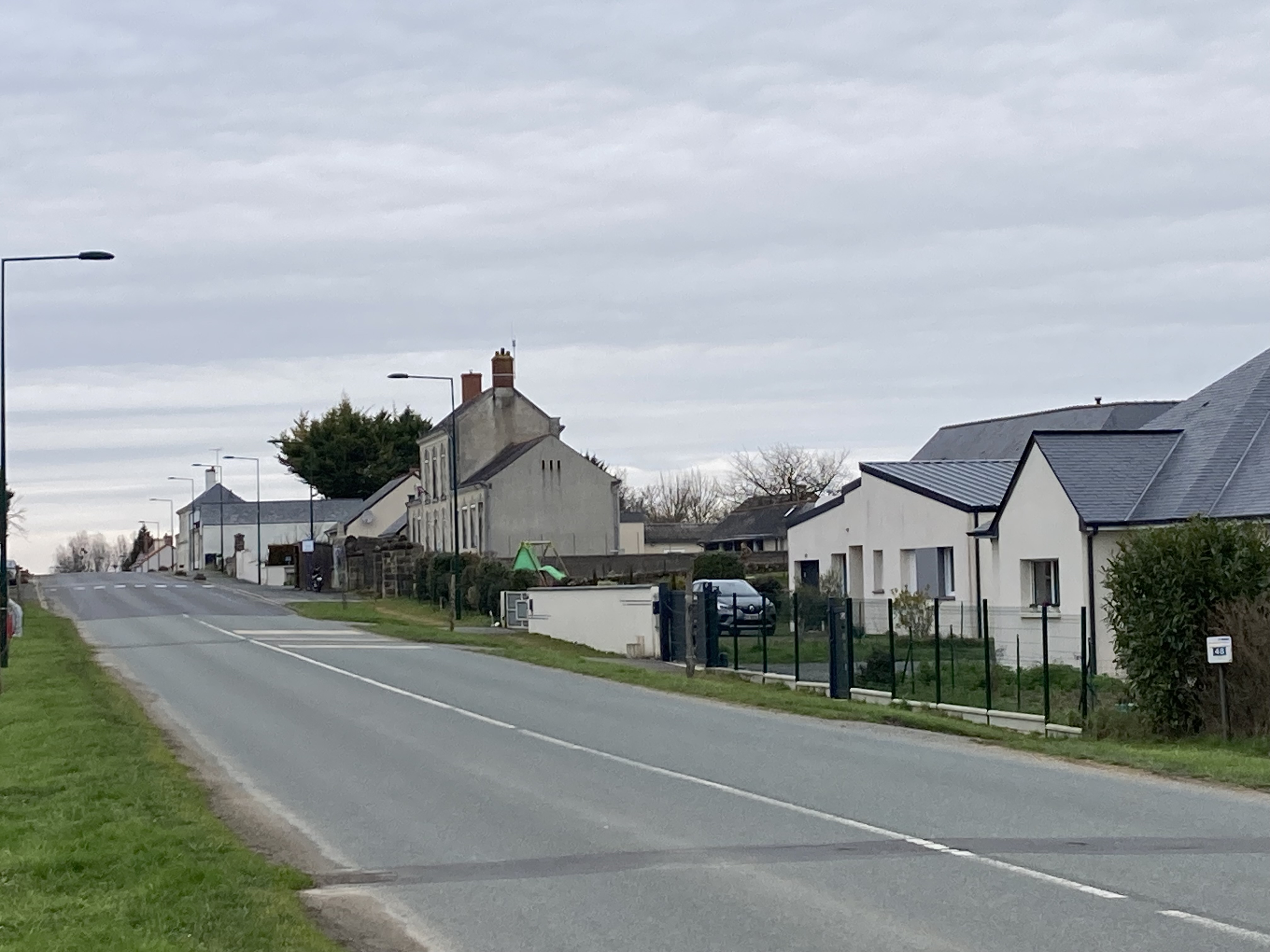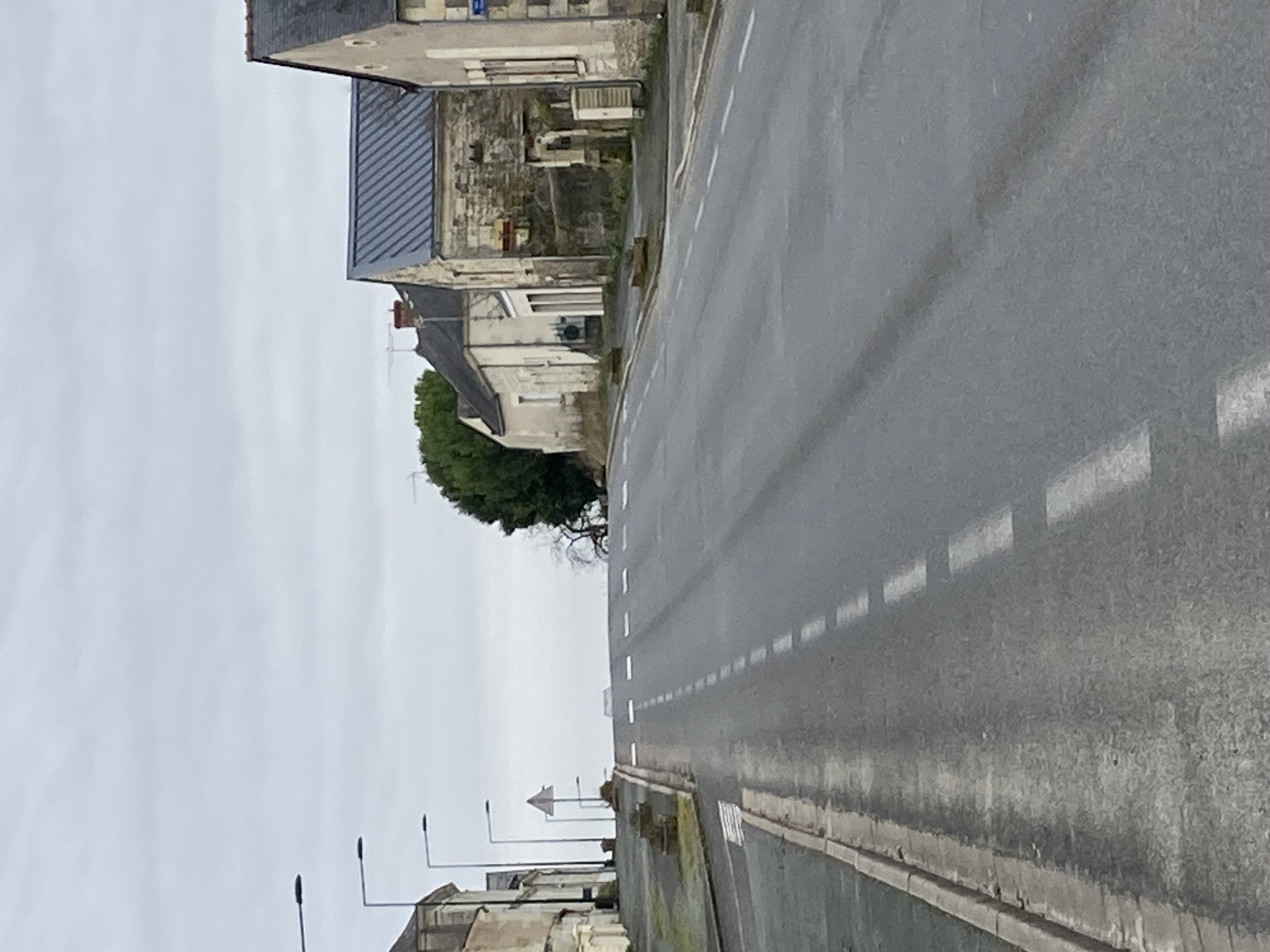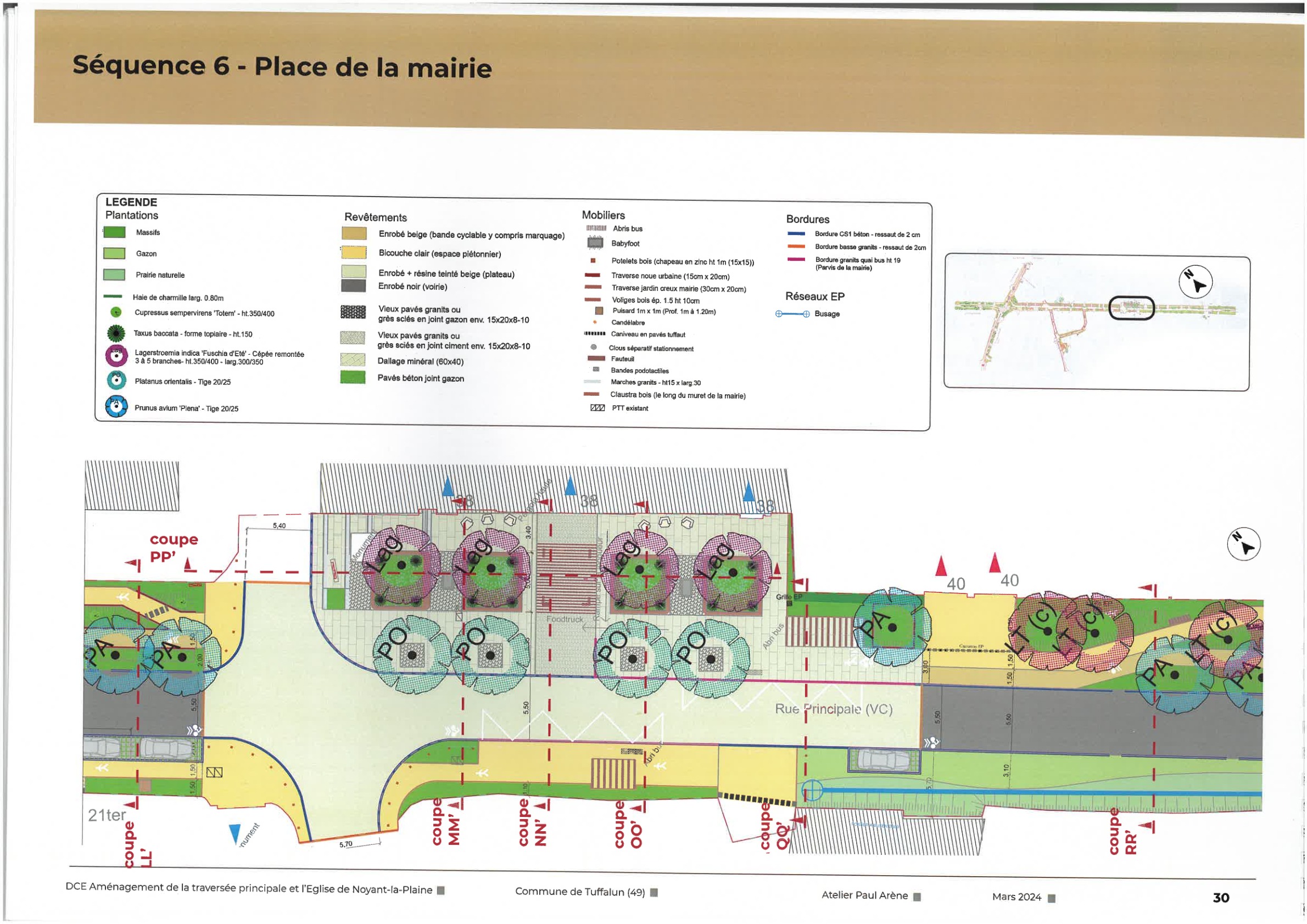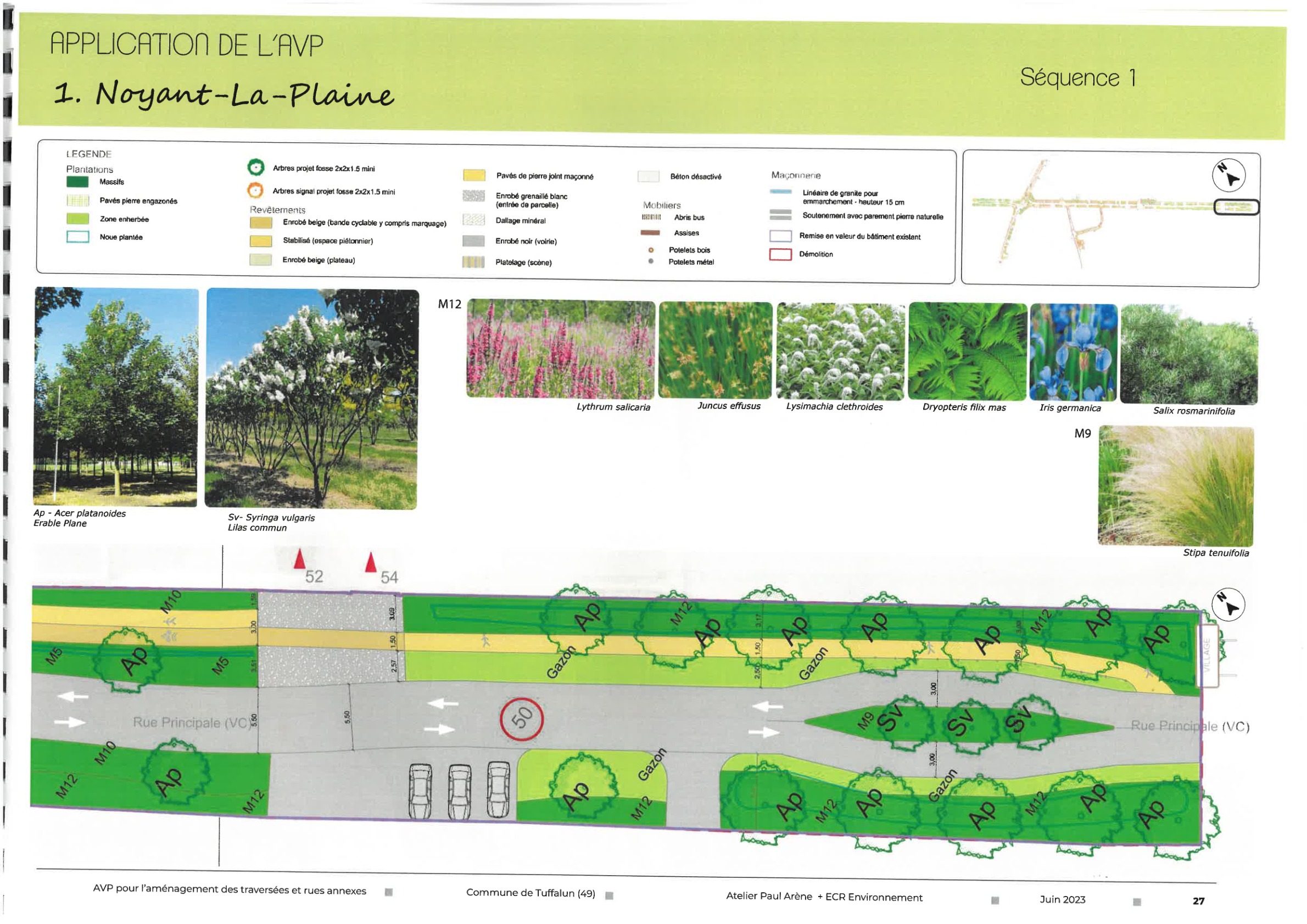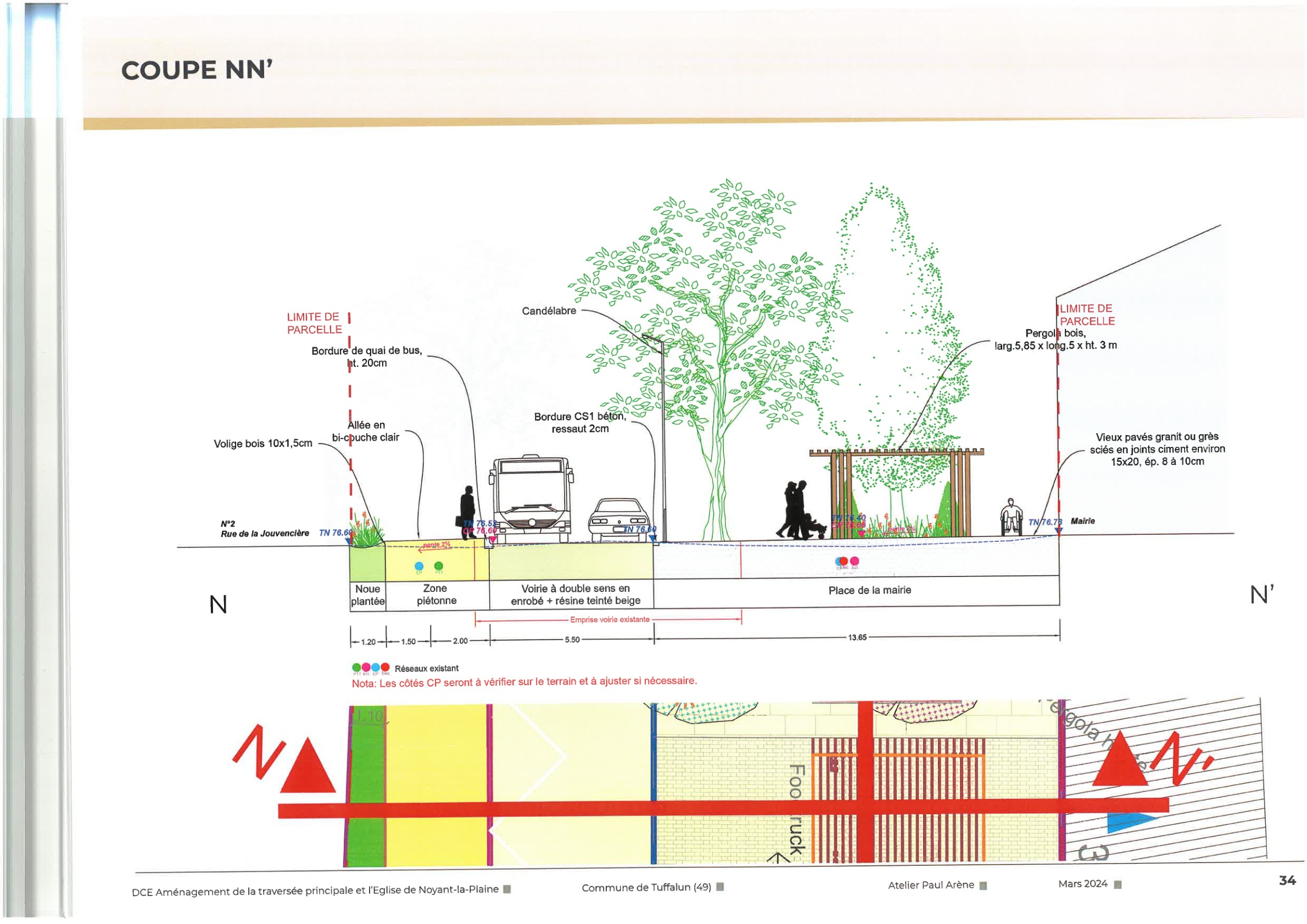A village as a park
Renaturation of the main street of the village of Noyant-la-Plaine (France))
A village as a park is the story of a village centre that was devoted to road traffic for decades, where all traces of greenery had disappeared. Today, nature is reclaiming its rights and allowing tourists, cyclists and residents to take back the village and share its uses.The aesthetics of the intervention will merge with the surrounding landscape, the biodiversity will expand again and the accessibility will be secrued for every one.
France
{Empty}
Prototype level
Yes
Yes
Yes
No
No
49003: Tuffalun (FR)
The renaturation of the main street of the village of Noyant-la-Plaine, one of the three villages of Tuffalun (France) has been designed to improve the living environment of the inhabitants and make the heart of the village more attractive to visitors. The aim is also to restore biodiversity and ecological balance. Finally, these transformations will make it possible to rediscover conviviality, to be able to meet again and to promote living together.
Renaturation
Biodiversity
Living together
Living environment
Intergenerational
The renaturation of the main street of the village of Noyant-la-Plaine should allow the return of biodiversity to the village centre. To renature this space, particular importance has been given to the management of rainwater, which will allow the preservation of wetlands, but also to the creation of islands of greenery. In the call for tenders, companies were clearly asked to use bio-sourced materials. The road surface will also be treated so that it can be reused. As for the street furniture, it will be a mixture of wood and recycled materials. It is important to restore an ecological balance in this sector. The aim is also to recreate a long-term sustainable relationship between the village and its surroundings.
The village as a park of Noyant-la-Plaine, one of the three villages constituting Tuffalun (France), entrance of the Loire Anjou Touraine Regional National Park, on the edge of the UNESCO Loire site, wants to go back its privileged lifestyle. The aim is to enjoy the pleasure to reconnect to green places, to live in harmony with the surrounding nature. Important for the stakeholders is to respect the past and re-find the trees. The village centre shall attract new visitors who will have the possibility to stroll in calm streets. The soft mobility is also an important point to reconnect the villages. The new calmed down area will brought a new meaning and hopefully allow the creation of events.
The village as a park of Noyant-la-Plaine has been redesigned to reconnect the spaces. It should be possible to share the flow between the various players in the village. Cycle paths provide better access to the village's services and shops. With the reduction in speed and the creation of intergenerational spaces, conviviality will once again be invited into the main thoroughfare of the village and strengthen exchanges between groups of residents. Modes of travel have been made safer for everyone. A living community will come together, interact and meet. We hope to create a positive and easy-to-follow example of land regeneration.
The residents were consulted from the start of the project. Once a route had been decided on, a guided walk was organised, bringing together residents, the consultancy firm, elected representatives, technicians and municipal staff in order to gather comments, opinions, positive and negative points, as well as ideas for improvement. A summary was then presented to the residents. Following the conclusions of the study, a contract was awarded and the key points of the work with the population were taken up again. The first sketches were presented to the municipal council, then the project was presented to the residents and they again worked in participatory workshops on the strengths and weaknesses of these proposals. After the project management contract was signed, a new presentation was made to the public, who were able to refine their comments. Just before work begins, a final meeting will be held to explain how the construction site will run.
Local Scale:
Residents of Noyant-la-Plaine were directly engaged with the project in 2019. Without the residents the project would not have been possible.
The Village as a park project team was a collaboration between:
Muncipality representatives
Cabinet Paul Arène (landscape architect)
State/Region
Sous-préfecture
Project manager of the program "villages d'avenir"
Agence de l'eau
Departement
Agglomération (water department)
Additional contributors:
CAUE (Conseil d'architecture, d'urbanisme et de l'environnement)
Vecteurs réseaux (topography)
Air Géo (technical support)
Cadegeau (rainwater management
Residents of Noyant-la-Plaine were directly engaged with the project in 2019. Without the residents the project would not have been possible.
The Village as a park project team was a collaboration between:
Muncipality representatives
Cabinet Paul Arène (landscape architect)
State/Region
Sous-préfecture
Project manager of the program "villages d'avenir"
Agence de l'eau
Departement
Agglomération (water department)
Additional contributors:
CAUE (Conseil d'architecture, d'urbanisme et de l'environnement)
Vecteurs réseaux (topography)
Air Géo (technical support)
Cadegeau (rainwater management
Cabinet Paul Arène has been asked to submit a preliminary design study and a tender document for the redevelopment of the main street in Noyant-la-Plaine
A steering committee of elected representatives monitored all stages of the design process. This committee has evolved over the years, incorporating new members who have always been involved in discussions with Atelier Paul Arène.
Atelier Paul Arène, in its role as project manager, called on partners to complement its skills and enrich the project:
- Ai&Géo for road construction and civil works and technical and coordination support
- The Cadegeau consultancy on the hydraulic aspects, to ensure the project's feasibility in terms of integrated rainwater management.
- Technical service providers such as Vecteur Réseaux for land surveys essential to the technical and financial sizing of the project
- Institutional partners such as the Conseil Departmental (roads department) for its advice and recommendations on sections of departmental road, or the Agence de l'Eau (water agency) for the hydraulic aspect, or the services of the agglomeration, managers of the drinking water supply networks for the coordination of concomitant repair work.
For its part, the mayor's office, through its elected representative Mme Guibert, has approached several public bodies and put together various public subsidies applications. (Two public funding bodies have already agreed to support the project:
- € 212,391 from the French government's Green fund for the renaturation of towns and villages.
- The Departement of Maine et Loire, which will provide € 95,626 in support of municipal investment and € 20,790 for rainwater management.
The Loire Bretagne Water Agency has also been asked to support the project.
A steering committee of elected representatives monitored all stages of the design process. This committee has evolved over the years, incorporating new members who have always been involved in discussions with Atelier Paul Arène.
Atelier Paul Arène, in its role as project manager, called on partners to complement its skills and enrich the project:
- Ai&Géo for road construction and civil works and technical and coordination support
- The Cadegeau consultancy on the hydraulic aspects, to ensure the project's feasibility in terms of integrated rainwater management.
- Technical service providers such as Vecteur Réseaux for land surveys essential to the technical and financial sizing of the project
- Institutional partners such as the Conseil Departmental (roads department) for its advice and recommendations on sections of departmental road, or the Agence de l'Eau (water agency) for the hydraulic aspect, or the services of the agglomeration, managers of the drinking water supply networks for the coordination of concomitant repair work.
For its part, the mayor's office, through its elected representative Mme Guibert, has approached several public bodies and put together various public subsidies applications. (Two public funding bodies have already agreed to support the project:
- € 212,391 from the French government's Green fund for the renaturation of towns and villages.
- The Departement of Maine et Loire, which will provide € 95,626 in support of municipal investment and € 20,790 for rainwater management.
The Loire Bretagne Water Agency has also been asked to support the project.
This project breathes new life into existing structures, preserving their historical significance and reducing waste. The collaboration between architects, engineers, and local communities fosters a deeper understanding of the area's cultural heritage and ensures that the design is tailored to the site's context.
By embracing interdisciplinarity, the project combines cutting-edge engineering techniques with landscape expression, creating a green space. Additionally, the design allows for flexibility and adaptability over time, enabling the structure to respond to changing environmental conditions. Climate-adaptation measures, such as rainwater harvesting systems, further enhance the project's resilience and sustainability. By embracing the natural environment, the project sets a new standard for urban revitalization, offering a model for future developments that prioritize circularity, community engagement, and environmental management.
By embracing interdisciplinarity, the project combines cutting-edge engineering techniques with landscape expression, creating a green space. Additionally, the design allows for flexibility and adaptability over time, enabling the structure to respond to changing environmental conditions. Climate-adaptation measures, such as rainwater harvesting systems, further enhance the project's resilience and sustainability. By embracing the natural environment, the project sets a new standard for urban revitalization, offering a model for future developments that prioritize circularity, community engagement, and environmental management.
The project's innovation is reflected in several points:
- Making the ground permeable again and renaturing of the village's public spaces to combat heat islands and bring life and biodiversity back to the heart of living spaces.
- Integrating rainwater management that allows water infiltration and soil remediation.
- Better living together, through the redevelopment of a central village road that today constitutes an obstacle to soft mobility and village life, and which tomorrow will lead to a general calming.
- Safety for soft modes of transport and the development of an intergenerational shared space, enhancing the life and mixed uses of the village (paths, squares, benches...).
- Working together, through the participative aspect of the studies and the involvement of citizens at every stage of the project.
- Making the ground permeable again and renaturing of the village's public spaces to combat heat islands and bring life and biodiversity back to the heart of living spaces.
- Integrating rainwater management that allows water infiltration and soil remediation.
- Better living together, through the redevelopment of a central village road that today constitutes an obstacle to soft mobility and village life, and which tomorrow will lead to a general calming.
- Safety for soft modes of transport and the development of an intergenerational shared space, enhancing the life and mixed uses of the village (paths, squares, benches...).
- Working together, through the participative aspect of the studies and the involvement of citizens at every stage of the project.
At local, regional, national and even European level, there are a number of former thoroughfares, such as the former departmental road through the village of Noyant-la-Plaine. These narrow, paved paths are sad and charmless. By involving the population and working alongside local, regional or state authorities, by using sourced materials, by respecting the biodiversity, it is entirely possible to replicate this project to allow nature to reclaim its rights.
This project attempts to address, at a local level, the global challenges associated with global warming (creation of cool spots), noise pollution (road redevelopment) and inclusivity (every effort is made to bring residents together and make visitors feel at home).
The Village as a park project is divided into sequences: the village entrances and exits, the main crossing and the central areas along this route. For each sequence, the issues and actions to be implemented were identified.
a) Village entrances and exits:
Important issues: Speed reduction, Landscape transition
Actions: Plant rhythm to slow vehicle speeds, Progressive narrowing of the track, A strong green and blue fabric: rainwater management areas
b) Main crossings:
Main issues: Crossing safety, Speed reduction, Noise pollution to be reduced, Reducing the waterproof surfaces
Actions: Significant tightening of the road network, Assertive plant punctuation, Parking organization, Integration of soft mobility.
c) Centres of citizen’s life: Town hall and municipal hall:
Main issues: Pooling of flows and "blurring of the road", Enhancing the heritage of urban facades, Activate ground floors and indoor/outdoor interfaces
Actions: Uniform floor treatment, Affirmation of the green treatment of facades, Incorporation of landmark trees, Parking organization, Integrated soft traffic - Strolling zone
Multidisciplinary process:
Cabinet Paul Arène has been asked to submit a preliminary design study and a tender document for the project. A steering committee of elected representatives monitored all stages of the design process. It has evolved over the years, incorporating new members. Atelier Paul Arène, in its role as project manager, called on partners to complement its skills and enrich the project: Air&Géo (road construction and civil works), Cadegeau consultancy (hydraulic aspects), Vecteur Réseaux (from technical to financial sizing of the project), Institutional partners such as the Conseil Departmental (roads), or Agence de l'Eau (water agency), or managers of the drinking water supply networks to coordinate repair work.
Throughout the project, public participation has been the guiding principle of its realisation.
a) Village entrances and exits:
Important issues: Speed reduction, Landscape transition
Actions: Plant rhythm to slow vehicle speeds, Progressive narrowing of the track, A strong green and blue fabric: rainwater management areas
b) Main crossings:
Main issues: Crossing safety, Speed reduction, Noise pollution to be reduced, Reducing the waterproof surfaces
Actions: Significant tightening of the road network, Assertive plant punctuation, Parking organization, Integration of soft mobility.
c) Centres of citizen’s life: Town hall and municipal hall:
Main issues: Pooling of flows and "blurring of the road", Enhancing the heritage of urban facades, Activate ground floors and indoor/outdoor interfaces
Actions: Uniform floor treatment, Affirmation of the green treatment of facades, Incorporation of landmark trees, Parking organization, Integrated soft traffic - Strolling zone
Multidisciplinary process:
Cabinet Paul Arène has been asked to submit a preliminary design study and a tender document for the project. A steering committee of elected representatives monitored all stages of the design process. It has evolved over the years, incorporating new members. Atelier Paul Arène, in its role as project manager, called on partners to complement its skills and enrich the project: Air&Géo (road construction and civil works), Cadegeau consultancy (hydraulic aspects), Vecteur Réseaux (from technical to financial sizing of the project), Institutional partners such as the Conseil Departmental (roads), or Agence de l'Eau (water agency), or managers of the drinking water supply networks to coordinate repair work.
Throughout the project, public participation has been the guiding principle of its realisation.

